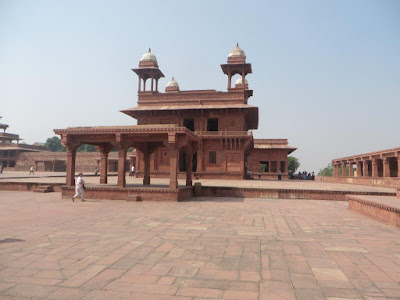We've been back a few days now, and India still dominates our thoughts! An incredible variety of sights and experiences, a number of mixed feelings, and no doubt done in far too little time, but on the other hand, a lifetime probably wouldn't be enough to do the whole country justice. Our short trip will have to suffice for us. However, I do propose to re-read Holy Cow.
My sleeping patterns are still disrupted, far more than I would have expected a 5½ hour change to cause. Moreover, it was only after I'd been back for a day or so that the effects started to manifest themselves. I think there's an age factor in play here.
I'm also conscious that a number of my posts glossed over some of the sights that we saw. Originally, I thought I might go back over some of the posts (done "on the run") and expand on them, but I'm not sure that this would really be productive.
There's one exception. In my earlier blog post, I didn't do justice to the Jantar Mantar at Jaipur. As I said then, this is a historic observatory at Jaipur, with large astronomical instruments. I see from Wikipedia that it's a collection of nineteen architectural astronomical instruments, built by the Rajput king Sawai Jai Singh II (who laid out the city of Jaipur), begun in 1727 and completed in 1734. It features the world's largest stone sundial, and is a UNESCO World Heritage site. There were five Jantar Mantar monuments in India; others are at Delhi, which dates from 1724, Varanasi and Ujjain. The fifth, the Muttra observatory, is gone.
We had a local guide take us around, and I'm sure his technical explanations were good. At first, the observatory seems to be just a curious collection of sculptures, but each construction has a specific purpose such as telling the time and measuring the positions of stars and planets, altitudes and calculating eclipses. I fear that most of what the guide told us was rather lost on our group! Just the same, the fact that so much detailed technical knowledge existed in those days was amazing in itself.
I won't attempt to describe the function of each instrument shown in the images below!
So, that's it for this blog. I'm going to give blogging a rest for a little while, but I anticipate resuming my day-to-day blog (or a successor?) shortly.
My sleeping patterns are still disrupted, far more than I would have expected a 5½ hour change to cause. Moreover, it was only after I'd been back for a day or so that the effects started to manifest themselves. I think there's an age factor in play here.
I'm also conscious that a number of my posts glossed over some of the sights that we saw. Originally, I thought I might go back over some of the posts (done "on the run") and expand on them, but I'm not sure that this would really be productive.
There's one exception. In my earlier blog post, I didn't do justice to the Jantar Mantar at Jaipur. As I said then, this is a historic observatory at Jaipur, with large astronomical instruments. I see from Wikipedia that it's a collection of nineteen architectural astronomical instruments, built by the Rajput king Sawai Jai Singh II (who laid out the city of Jaipur), begun in 1727 and completed in 1734. It features the world's largest stone sundial, and is a UNESCO World Heritage site. There were five Jantar Mantar monuments in India; others are at Delhi, which dates from 1724, Varanasi and Ujjain. The fifth, the Muttra observatory, is gone.
We had a local guide take us around, and I'm sure his technical explanations were good. At first, the observatory seems to be just a curious collection of sculptures, but each construction has a specific purpose such as telling the time and measuring the positions of stars and planets, altitudes and calculating eclipses. I fear that most of what the guide told us was rather lost on our group! Just the same, the fact that so much detailed technical knowledge existed in those days was amazing in itself.
I won't attempt to describe the function of each instrument shown in the images below!
So, that's it for this blog. I'm going to give blogging a rest for a little while, but I anticipate resuming my day-to-day blog (or a successor?) shortly.
































